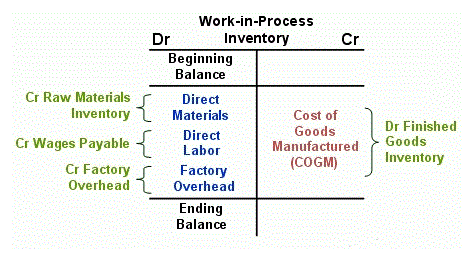
This helps in creating detailed budgets that cover all aspects of production, thereby avoiding “surprise” costs and ensuring financial stability. By using Brahmin Solutions, you can automate the process of calculating and tracking your manufacturing costs, saving time, reducing errors, and ultimately boosting your bottom line. Indirect Manufacturing Costs are the expenses that support the production process but aren’t directly tied to a specific product.
Finding the Cost of Goods Sold (COGS) using COGM
George calculates the TMC by adding the cost of direct materials, the cost of direct labor and the overhead costs. Calculate direct and indirect costs to improve pricing, limit expenses, and boost profits. Direct labor cost is calculated by multiplying the https://www.bookstime.com/ total worked hours and the labor rate per hour.
How to calculate total manufacturing cost

One thing to watch out for is the costs that come from depreciation in the value of your raw materials. Direct Labor Cost comprises the wages, salaries, and benefits paid to employees directly involved in the manufacturing process. These employees work directly on the production line and contribute directly to the creation of the goods. From Cost accounting and Financial statements perspective, having a detailed product costing with a clearly defined cost structure for Finished products is important. Major cost components of manufacturing are machine equipment cost, energy costs, manufacturing expenses, administrative expenses and other hidden costs.

Calculating the overhead cost for manufacturing one unit
Direct material costs can be found by adding the cost of purchased raw materials to their beginning inventory and then subtracting their ending inventory. The total manufacturing cost formula is a simple equation in which all of these are added together. Total manufacturing cost is a financial metric that expresses the total amount of funds spent on all production activities during a financial period. In plain terms, it is the total cost a company spends on manufacturing its products. As such, calculating TMC precisely is invaluable for anyone looking to gain more insight into their manufacturing cost accounting fundamentals.

All you need to do is calculate the direct material cost according to the formula; which in Excel you can do it among the relevant cells. A low manufacturing overhead rate signifies efficient and effective resource utilization within your business. However, a higher rate may suggest your production process is experiencing delays or inefficiencies. The total manufacturing costs, which include the following, are then determined. Ensuring optimal productivity is crucial to managing manufacturing costs efficiently. Manufacturing costs impact pricing strategy, cost control, innovation, quality of materials, and ultimately, profitability.
Total Manufacturing Cost – What is it and How to Calculate it?
- Considered an indirect cost, manufacturing overheads are expenses that are not directly related to the production of goods, but they are very much necessary for the production process to occur.
- Finally, we deducted the monthly depreciation value from the capital assets and organizational resources to find the actual cash paid for manufacturing overhead.
- Keep your business protected and cost-efficient with updated insurance coverage.
- By closely monitoring and analyzing these costs, we can make informed decisions, optimize our operations, and ultimately increase profitability.
- The manufacturing overhead rate is a key metric that helps businesses allocate indirect manufacturing costs to their products.
- First, determine how many hours of work are directly involved in manufacturing the product.
- Total Variable Cost is the cost that is directly connected with the production of any item.
To calculate this, divide the number of units produced by the number of hours needed to produce them. With all this valuable information under your belt, you can better track manufacturing costs as they pertain to your workforce. Another commonly used term for manufacturing costs is product costs, which also refer to the costs of manufacturing a product. Here are some frequently asked questions (FAQs) and answers that address key concepts related to manufacturing costs.
- Effectively managing expenses in manufacturing isn’t just an option — it’s a necessity.
- Regularly evaluating and analyzing this metric empowers you to optimize operations, enhance efficiency, and maximize profitability.
- Brahmin Solutions helps by centralizing all indirect costs such as utilities, rent, and maintenance costs.
- These terms encompass the costs incurred in producing goods, including direct materials, direct labor, and manufacturing overhead.
- It gives a clear idea of the expenses involved in producing goods, allowing for better financial planning and decision-making.
Total Variable Cost vs Total Fixed Cost
This is because companies can sell their products at a lower price, making them more affordable to consumers. Additionally, lower costs can help companies expand their operations and hire more workers — boosting the economy by creating new jobs and increasing consumer spending. This is the formula to calculate applied manufacturing overhead in manufacturing.
Accounting
Manufacturing overhead is referred to as indirect costs because it’s hard to trace them to the product. A final product’s cost is based on a pre-determined overhead absorption rate. That overhead absorption rate is the manufacturing overhead costs per unit, called the cost driver, adjusting entries which is labor costs, labor hours and machine hours. Much like with direct materials, direct labor costs constitute all labor that goes toward converting materials into finished goods. In other words, the direct labor costs that go into the total manufacturing cost calculation are only made up of staff directly involved in the production part of the business. Use this calculator to determine your total manufacturing cost by entering your direct materials, direct labor, and manufacturing overhead costs.
Integration With other Business Systems
Has the business of manufacturing and selling readymade garments in the market. It is important to note that these costs are short-term and can be adjusted rather instantaneously to maintain a variable cost per unit graph within feasible limits. It has total manufacturing cost formula a direct correlation to production; it increases with the increase in every unit of production. They are exactly the opposite of fixed costs that do not change due to changes in production. Detailed product costing is important for informed decision-making around pricing in manufacturing.













